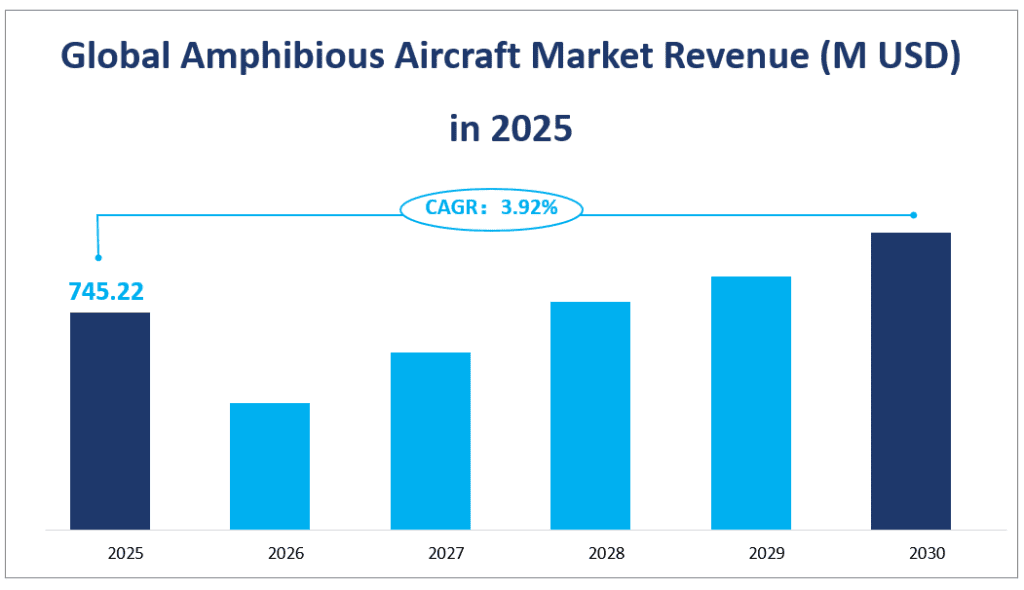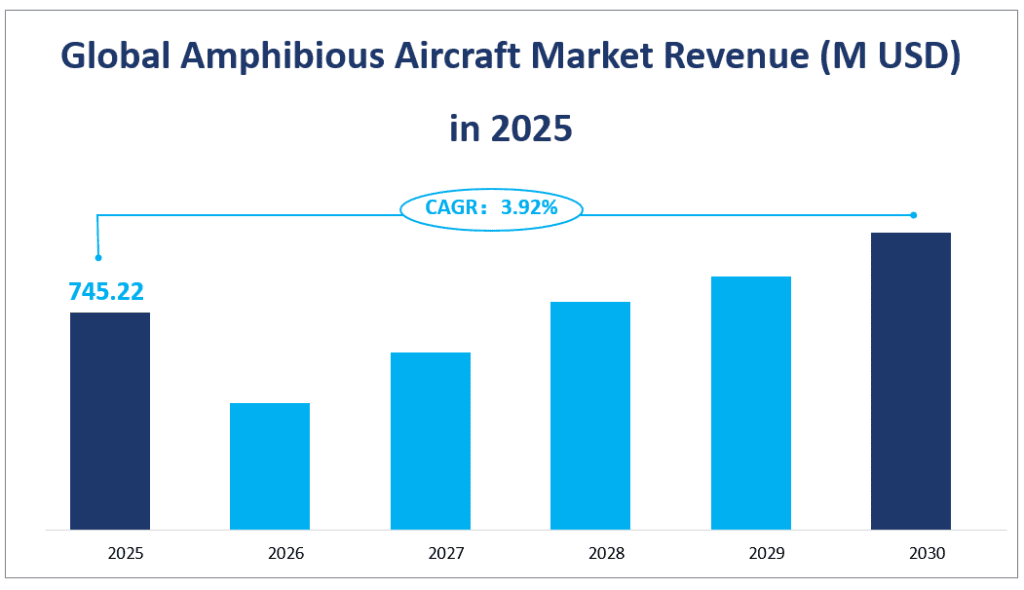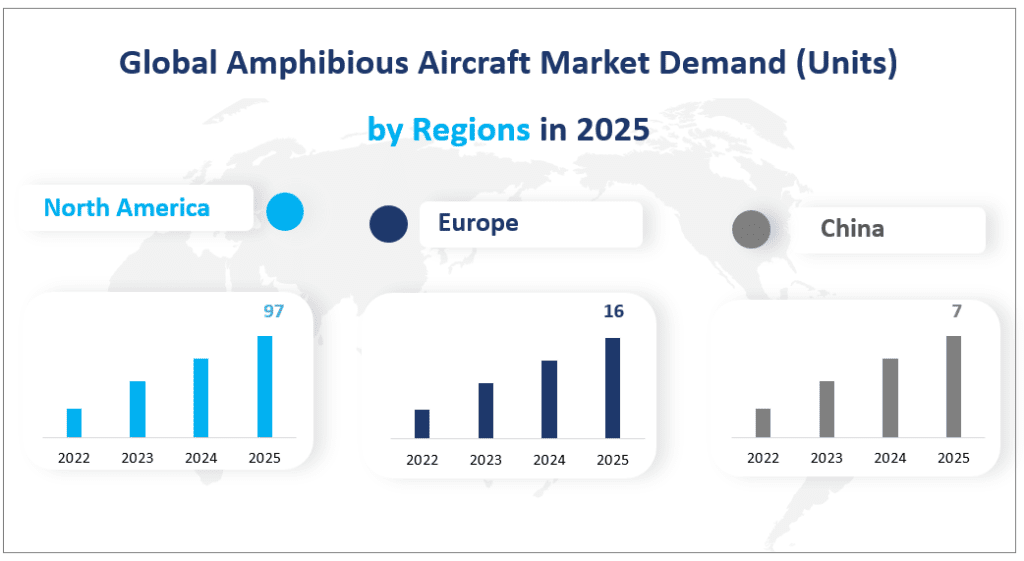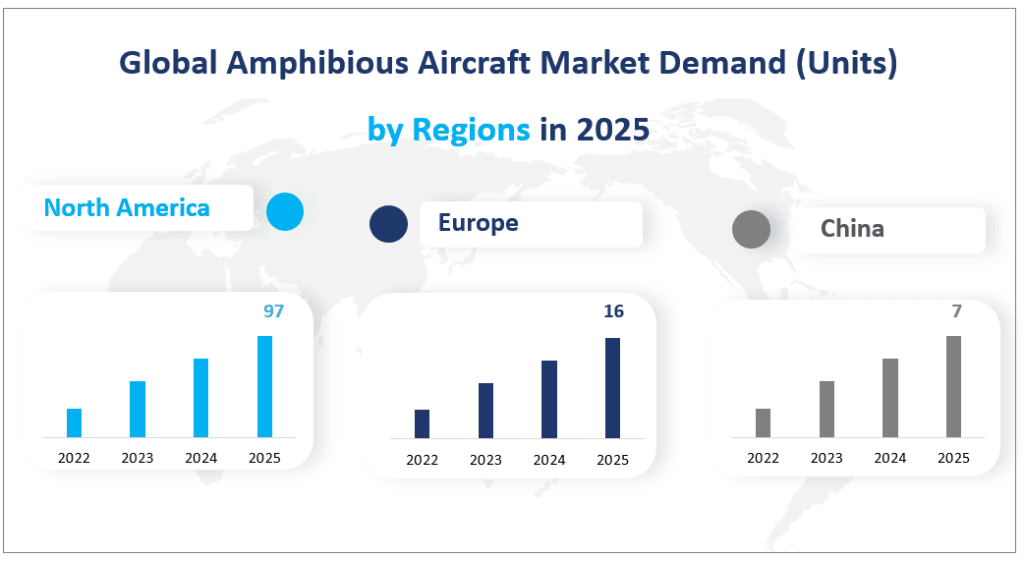1. Global Amphibious Aircraft Market Definition
The global amphibious aircraft market is projected to reach a revenue of $745.22 million by 2025 with a CAGR of 3.92% from 2025 to 2030. Amphibious aircraft are versatile machines designed to take off and land on both water and land. They are typically equipped with floats that have retractable wheels, allowing them to operate from water bodies as well as traditional runways. These aircraft serve a variety of purposes, including firefighting, search-and-rescue operations, maritime patrol, cargo and passenger transportation, and recreational activities.
Amphibious aircraft have gained significant attention in recent years due to their unique capabilities and the expanding range of applications they offer. The market for these aircraft is driven by increasing demand from both civilian and military sectors. Civilian uses primarily include water-based entertainment and commercial activities such as delivering supplies to remote areas, while military applications encompass maritime surveillance, anti-submarine operations, and forest fire fighting.
Global Amphibious Aircraft Market Revenue (M USD) in 2025


2. Driving Factors of Amphibious Aircraft Market
The growth of the global amphibious aircraft market is influenced by several key factors. On the positive side, the increasing demand from the military sector is a significant driver. Defense budgets are growing globally, with countries like the United States, Japan, and China investing heavily in advanced amphibious aircraft for their navies. The need for versatile aircraft that can operate in various environments, such as coastal regions and remote islands, is driving the demand for amphibious aircraft.
Additionally, technological advancements are improving the performance and capabilities of these aircraft, making them more efficient and reliable.
Another driving factor is the rising interest in water-based recreational activities. As the global economy recovers and disposable incomes increase, more people are seeking unique and adventurous experiences, such as water-based aviation. This trend is particularly evident in developed regions like North America and Europe, where the market for light sport amphibious aircraft is growing steadily.
3. Limiting Factors of Amphibious Aircraft Market
However, the market also faces several limiting factors. One of the primary challenges is the high cost of production and maintenance. Amphibious aircraft require specialized materials and advanced engineering, which can significantly increase their production costs. Additionally, the market is highly regulated, with stringent safety and environmental standards that manufacturers must adhere to. These regulations can add to the cost and complexity of bringing new products to market.
Another limiting factor is the fluctuation in raw material prices. Key materials such as titanium alloys, composite materials, and high-grade aluminum are subject to market volatility, which can impact the profitability of manufacturers. Furthermore, the market is highly concentrated, with a few major players dominating the industry. This concentration can limit competition and innovation, making it difficult for new entrants to gain a foothold.
4. Analysis of Amphibious Aircraft Market Segment
Product Types
By 2025, the Light Sport Amphibious Aircraft segment is projected to generate a revenue of $291.23 million, while the Multipurpose Amphibious Aircraft segment is expected to reach $453.99 million. This indicates that the Multipurpose Amphibious Aircraft segment will hold the largest market share, driven by its versatility and broader range of applications.
Despite its significant growth potential, the Light Sport Amphibious Aircraft segment faces challenges such as regulatory hurdles and the need for specialized training for operators. Additionally, the market is highly competitive, with several manufacturers vying for a share of the relatively smaller market size. This competition can limit price increases and profit margins.
Multipurpose Amphibious Aircraft are larger and more versatile, capable of performing a wide range of missions. These aircraft are used for firefighting, search-and-rescue operations, maritime patrol, and cargo and passenger transportation. Their ability to operate in various environments makes them highly valuable for both civilian and military applications.
Analysis of Different Applications
By 2025, the civilian application segment is projected to generate a revenue of $514.42 million, while the military application segment is expected to reach $230.80 million. This indicates that the civilian application segment will hold the largest market share, driven by the growing demand for water-based recreational activities and commercial operations.
Civilian applications of amphibious aircraft include water-based entertainment, such as sightseeing tours and recreational flying, as well as commercial operations like delivering supplies to remote areas and maritime patrol. The market for civilian applications is driven by increasing interest in water-based activities and the growing disposable incomes of consumers in developed regions like North America and Europe.
Military applications of amphibious aircraft include firefighting, search-and-rescue operations, maritime patrol, and anti-submarine warfare. These aircraft are highly valued for their versatility and ability to operate in various environments, making them essential for modern navies and coast guards.
The market for military applications is driven by increasing defense spending and the need for versatile aircraft that can perform multiple roles. Countries with significant coastlines and maritime interests, such as the United States, Japan, and China, are investing heavily in these aircraft to enhance their maritime capabilities. Additionally, the growing demand for efficient firefighting solutions, especially in regions prone to wildfires, is driving the market for these versatile aircraft.
The military application segment benefits from technological advancements that improve their performance and capabilities. Innovations such as advanced materials, more efficient engines, and improved aerodynamics are making these aircraft more efficient and reliable. However, the high cost of production and maintenance remains a challenge. These aircraft require specialized materials and advanced engineering, which can significantly increase their production costs. Additionally, the market is highly regulated, with stringent safety and environmental standards that manufacturers must adhere to.
Market Revenue by Segment
| Market Revenue (M USD) in 2025 | ||
| By Type | Light Sport Amphibious Aircraft | 291.23 |
| Multipurpose Amphibious Aircraft | 453.99 | |
| By Application | Civilian | 514.42 |
| Military | 230.80 |
5. Analysis of Amphibious Aircraft Market Demand by Major Region in 2025
By 2025, the demand for amphibious aircraft is projected to be highest in North America, followed by Europe and Asia-Pacific regions. Specifically, North America is expected to demand 97 units, Europe 16 units, and China 7 units. This indicates that North America will be the largest regional market by demand, driven by its robust economy, advanced technological capabilities, and significant investments in both civilian and military applications.
North America is projected to be the largest market for amphibious aircraft by 2025, with a demand of 190 units. The region’s strong economic foundation, advanced technological capabilities, and significant investments in both civilian and military applications drive this demand. The United States, in particular, is a major player in the market, with companies like Viking Air Ltd. and Textron Aviation leading the industry. The demand for amphibious aircraft in North America is driven by the need for versatile aircraft that can perform multiple roles, including firefighting, search-and-rescue operations, and maritime patrol. Additionally, the growing interest in water-based recreational activities and the increasing disposable incomes of consumers in the region contribute to the demand for light sport amphibious aircraft.
Europe is expected to demand 36 units of amphibious aircraft by 2025. The region’s demand is driven by its strong industrial base, advanced technological capabilities, and significant investments in military and civilian applications. European countries like France, Germany, and the United Kingdom have a long history of investing in advanced aviation technologies, and this trend is expected to continue. The demand for amphibious aircraft in Europe is driven by the need for versatile aircraft that can perform multiple roles, including maritime patrol, search-and-rescue operations, and firefighting.
Global Amphibious Aircraft Market Demand (Units) by Regions in 2025


6. Top 3 Companies in the Amphibious Aircraft Market
Company Introduction and Business Overview:
Viking Air Ltd., established in 1970 and headquartered in Sidney, British Columbia, Canada, is a global leader in utility aircraft services and the manufacturer of Series 400 and Guardian 400 Twin Otter aircraft. Viking Air is the Original Equipment Manufacturer (OEM) and Type Certificate holder for all out-of-production De Havilland Canada aircraft and the Canadair Amphibious Aerial Firefighting aircraft fleet.
Products Offered:
Viking Air’s product portfolio includes the DHC-515 FIREFIGHTER™, which is designed for aerial firefighting operations. The company also offers comprehensive spare support for the CL-215, CL215T & CL-415 aircraft, ensuring that these critical firefighting aircraft remain operational.
In 2022, Viking Air Ltd. reported a sales revenue of $424.28 million.
Company Introduction and Business Overview:
United Aircraft Corporation (UAC), established in 2006 and headquartered in Moscow, Russia, designs and manufactures a wide range of civil and military aircraft. The company provides maintenance, upgrade, repair, and utilization services for both civil and military aircraft. UAC is known for its long-haul, medium-haul, and short-haul civil aircraft, as well as its military aircraft, including long-range strategic aircraft, naval aircraft, and combat trainer aircraft.
Products Offered:
UAC’s amphibious aircraft offerings include the Be-200, which is designed for aerial firefighting, search-and-rescue operations, and passenger transportation. The Be-200 can be quickly reconfigured for various missions, including medical evacuation and environmental monitoring.
In 2022, United Aircraft Corporation reported a sales revenue of $372.00 million.
Company Introduction and Business Overview:
Kodiak aircraft, established in 2001 and headquartered in Sandpoint, Idaho, USA, is a leading manufacturer of short takeoff and landing (STOL) aircraft. The company’s mission is to design and produce the next generation of STOL aircraft capable of bringing services and heavy supplies to the most remote regions on the planet. Kodiak aircraft is known for its rugged and versatile Kodiak 100 series, which fills a niche between helicopters and business jets.
Products Offered:
Kodiak Aircraft’s product portfolio includes the Kodiak 100 Series III, which is designed for versatility and performance. The aircraft can operate from unprepared strips and water with floats, making it ideal for remote operations. The Kodiak 100 Series III is equipped with advanced avionics and safety features, making it a reliable choice for various missions.
In 2022, Kodiak Aircraft reported a sales revenue of $47.57 million.
Major Players
| Company Name | Plants Distribution | Sales Region |
| Viking Air Ltd. | Canada | Mainly in North America and Europe |
| United Aircraft Corporation | Russia | Mainly in Europe and Asia |
| Kodiak aircraft | USA | Mainly in Americas and Asia |
| Textron Aviation | USA and Mexico | Mainly in North America |
| ICON Aircraft, Inc. | USA and Mexico | Mainly in North America |
| Progressive Aerodyne | USA | Mainly in USA and Canada |
| LISA Airplanes | France | Mainly in Europe |
| Aero Adventure LLC | USA | North America, Australia, New Zealand and Europe |
| ShinMaywa Industries, Ltd. | Japan | Japan |
Chapter 1: Amphibious Aircraft Introduction and Market Overview
1.1 Objectives of the Study
1.2 Overview of Amphibious Aircraft
1.3 Amphibious Aircraft Market Scope and Market Size Estimation
1.3.1 Market Concentration Ratio and Market Maturity Analysis
1.3.2 Global Amphibious Aircraft Revenue and Growth Rate from 2017-2027
1.4 Market Segmentation
1.4.1 Types of Amphibious Aircraft
1.4.2 Applications of Amphibious Aircraft
1.4.3 Research Regions
1.5 Market Dynamics
1.5.1 Amphibious Aircraft Industry Trends
1.5.2 Amphibious Aircraft Drivers
1.5.3 Amphibious Aircraft Market Challenges
1.5.4 Amphibious Aircraft Market Restraints
1.6 Industry News and Policies by Regions
1.6.1 Industry News
1.6.2 Industry Policies
1.7 Mergers & Acquisitions, Expansion Plans
1.8 Amphibious Aircraft Industry Development Trends under COVID-19 Outbreak
1.8.1 Global COVID-19 Status Overview
1.8.2 Influence of COVID-19 Outbreak on Amphibious Aircraft Industry Development
1.9 Impact of Russia and Ukraine War
Chapter 2: Industry Chain Analysis
2.1 Upstream Raw Material Supply and Demand Analysis
2.1.1 Global Amphibious Aircraft Major Upstream Raw Material and Suppliers
2.1.2 Raw Material Cost Analysis
2.2 Major Players of Amphibious Aircraft
2.2.1 Major Players Manufacturing Base of Amphibious Aircraft in 2021
2.2.2 Major Players Market Distribution in 2021
2.3 Amphibious Aircraft Manufacturing Cost Structure Analysis
2.3.1 Production Process Analysis
2.3.2 Manufacturing Cost Structure of Amphibious Aircraft
2.3.3 Labor Cost of Amphibious Aircraft
2.4 Market Channel Analysis of Amphibious Aircraft
2.5 Major Down Stream Customers by Application
Chapter 3: Global Amphibious Aircraft Market, by Type
3.1 Global Amphibious Aircraft Revenue and Market Share by Type (2017-2022)
3.2 Global Amphibious Aircraft Consumption and Market Share by Type (2017-2022)
3.3 Global Amphibious Aircraft Revenue and Growth Rate by Type (2017-2022)
3.3.1 Global Amphibious Aircraft Revenue and Growth Rate of Light Sport Amphibious Aircraft
3.3.2 Global Amphibious Aircraft Revenue and Growth Rate of Multipurpose Amphibious Aircraft
3.4 Global Amphibious Aircraft Price Analysis by Type (2017-2022)
Chapter 4: Amphibious Aircraft Market, by Application
4.1 Downstream Market Overview
4.2 Global Amphibious Aircraft Consumption and Market Share by Application (2017-2022)
4.3 Global Amphibious Aircraft Consumption and Growth Rate by Application (2017-2022)
4.3.1 Global Amphibious Aircraft Consumption and Growth Rate of Civilian (2017-2022)
4.3.2 Global Amphibious Aircraft Consumption and Growth Rate of Military (2017-2022)
Chapter 5: Global Amphibious Aircraft Consumption, Revenue (M USD) by Region (2017-2022)
5.1 Global Amphibious Aircraft Revenue and Market Share by Region (2017-2022)
5.2 Global Amphibious Aircraft Consumption and Market Share by Region (2017-2022)
5.3 Global Amphibious Aircraft Consumption, Revenue, Price and Gross Margin (2017-2022)
5.4 North America Amphibious Aircraft Consumption, Revenue, Price and Gross Margin (2017-2022)
5.4.1 North America Amphibious Aircraft Market Under COVID-19
5.4.2 North America Amphibious Aircraft SWOT Analysis
5.5 Europe Amphibious Aircraft Consumption, Revenue, Price and Gross Margin (2017-2022)
5.5.1 Europe Amphibious Aircraft Market Under COVID-19
5.5.2 Europe Amphibious Aircraft SWOT Analysis
5.6 China Amphibious Aircraft Consumption, Revenue, Price and Gross Margin (2017-2022)
5.6.1 China Amphibious Aircraft Market Under COVID-19
5.6.2 China Amphibious Aircraft SWOT Analysis
5.7 Japan Amphibious Aircraft Consumption, Revenue, Price and Gross Margin (2017-2022)
5.7.1 Japan Amphibious Aircraft Market Under COVID-19
5.7.2 Japan Amphibious Aircraft SWOT Analysis
5.8 Middle East and Africa Amphibious Aircraft Consumption, Revenue, Price and Gross Margin (2017-2022)
5.8.1 Middle East and Africa Amphibious Aircraft Market Under COVID-19
5.8.2 Middle East and Africa Amphibious Aircraft SWOT Analysis
5.9 India Amphibious Aircraft Consumption, Revenue, Price and Gross Margin (2017-2022)
5.9.1 India Amphibious Aircraft Market Under COVID-19
5.9.2 India Amphibious Aircraft SWOT Analysis
5.10 South America Amphibious Aircraft Consumption, Revenue, Price and Gross Margin (2017-2022)
5.10.1 South America Amphibious Aircraft Market Under COVID-19
5.10.2 South America Amphibious Aircraft SWOT Analysis
5.11 South Korea Amphibious Aircraft Consumption, Revenue, Price and Gross Margin (2017-2022)
5.11.1 South Korea Amphibious Aircraft Market Under COVID-19
5.11.2 South Korea Amphibious Aircraft SWOT Analysis
5.12 Southeast Asia Amphibious Aircraft Consumption, Revenue, Price and Gross Margin (2017-2022)
5.12.1 Southeast Asia Amphibious Aircraft Market Under COVID-19
5.12.2 Southeast Asia Amphibious Aircraft SWOT Analysis
Chapter 6: Global Amphibious Aircraft Production by Top Regions (2017-2022)
6.1 Global Amphibious Aircraft Production by Top Regions (2017-2022)
6.2 North America Amphibious Aircraft Production and Growth Rate
6.3 Europe Amphibious Aircraft Production and Growth Rate
6.4 Japan Amphibious Aircraft Production and Growth Rate
Chapter 7: Global Amphibious Aircraft Consumption by Regions (2017-2022)
7.1 Global Amphibious Aircraft Consumption by Regions (2017-2022)
7.2 North America Amphibious Aircraft Consumption and Growth Rate
7.3 Europe Amphibious Aircraft Consumption and Growth Rate
7.4 China Amphibious Aircraft Consumption and Growth Rate
7.5 Japan Amphibious Aircraft Consumption and Growth Rate
7.6 Middle East & Africa Amphibious Aircraft Consumption and Growth Rate
7.7 India Amphibious Aircraft Consumption and Growth Rate
7.8 South America Amphibious Aircraft Consumption and Growth Rate
7.9 South Korea Amphibious Aircraft Consumption and Growth Rate
7.10 Southeast Asia Amphibious Aircraft Consumption and Growth Rate
Chapter 8: Competitive Landscape
8.1 Competitive Profile
8.2 Viking Air Ltd.
8.2.1 Company Profiles
8.2.2 Amphibious Aircraft Product Profiles, Application and Specification
8.2.3 Viking Air Ltd. Sales, Value, Price, Gross Margin 2017-2022
8.2.4 Company Recent Development
8.3 United Aircraft Corporation
8.3.1 Company Profiles
8.3.2 Amphibious Aircraft Product Profiles, Application and Specification
8.3.3 United Aircraft Corporation Sales, Value, Price, Gross Margin 2017-2022
8.3.4 Company Recent Development
8.4 Kodiak aircraft
8.4.1 Company Profiles
8.4.2 Amphibious Aircraft Product Profiles, Application and Specification
8.4.3 Kodiak aircraft Sales, Value, Price, Gross Margin 2017-2022
8.4.4 Company Recent Development
8.5 Textron Aviation
8.5.1 Company Profiles
8.5.2 Amphibious Aircraft Product Profiles, Application and Specification
8.5.3 Textron Aviation Sales, Value, Price, Gross Margin 2017-2022
8.5.4 Company Recent Development
8.6 ICON Aircraft, Inc.
8.6.1 Company Profiles
8.6.2 Amphibious Aircraft Product Profiles, Application and Specification
8.6.3 ICON Aircraft, Inc. Sales, Value, Price, Gross Margin 2017-2022
8.6.4 Company Recent Development
8.7 Progressive Aerodyne
8.7.1 Company Profiles
8.7.2 Amphibious Aircraft Product Profiles, Application and Specification
8.7.3 Progressive Aerodyne Sales, Value, Price, Gross Margin 2017-2022
8.7.4 Company Recent Development
8.8 LISA Airplanes
8.8.1 Company Profiles
8.8.2 Amphibious Aircraft Product Profiles, Application and Specification
8.8.3 LISA Airplanes Sales, Value, Price, Gross Margin 2017-2022
8.9 Aero Adventure LLC
8.9.1 Company Profiles
8.9.2 Amphibious Aircraft Product Profiles, Application and Specification
8.9.3 Aero Adventure LLC Sales, Value, Price, Gross Margin 2017-2022
8.9.4 Company Recent Development
8.10 ShinMaywa Industries, Ltd.
8.10.1 Company Profiles
8.10.2 Amphibious Aircraft Product Profiles, Application and Specification
8.10.3 ShinMaywa Sales, Value, Price, Gross Margin 2017-2022
8.10.4 Company Recent Development
Chapter 9: Global Amphibious Aircraft Market Analysis and Forecast by Type and Application
9.1 Global Amphibious Aircraft Market Revenue & Volume Forecast, by Type (2022-2027)
9.1.1 Light Sport Amphibious Aircraft Market Revenue and Volume Forecast (2022-2027)
9.1.2 Multipurpose Amphibious Aircraft Market Revenue and Volume Forecast (2022-2027)
9.2 Global Amphibious Aircraft Market Revenue & Volume Forecast, by Application (2022-2027)
9.2.1 Civilian Market Revenue and Volume Forecast (2022-2027)
9.2.2 Military Market Revenue and Volume Forecast (2022-2027)
Chapter 10: Amphibious Aircraft Market Supply and Demand Forecast by Region
10.1 North America Market Supply and Demand Forecast (2022-2027)
10.2 Europe Market Supply and Demand Forecast (2022-2027)
10.3 China Market Supply and Demand Forecast (2022-2027)
10.4 Japan Market Supply and Demand Forecast (2022-2027)
10.5 Middle East and Africa Market Supply and Demand Forecast (2022-2027)
10.6 India Market Supply and Demand Forecast (2022-2027)
10.7 South America Market Supply and Demand Forecast (2022-2027)
10.8 South Korea Market Supply and Demand Forecast (2022-2027)
10.9 Southeast Asia Market Supply and Demand Forecast (2022-2027)
10.10 Explanation of Market Size Trends by Region
10.11 Amphibious Aircraft Market Trends Analysis
Chapter 11: New Project Feasibility Analysis
11.1 Industry Barriers and New Entrants SWOT Analysis
Chapter 12: Research Finding and Conclusion
Chapter 13: Appendix
13.1 Methodology
13.2 Research Data Source
13.2.1 Secondary Data
13.2.2 Primary Data
13.2.3 Market Size Estimation
13.2.4 Legal Disclaimer
